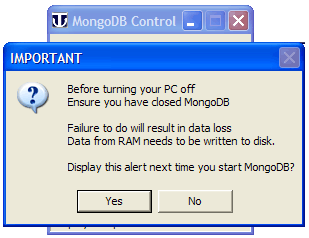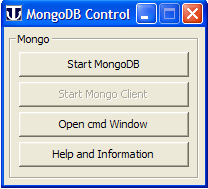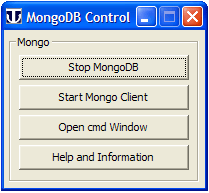MongoDB: Standalone: Difference between revisions
(New page: {{Nav MongoDB}} '''''MongoDB''''' == Introduction == Uniform Server MongoDB Standalone extracts MongoDB server and associated files. Extracted files are portable meaning you can copy the m...) |
(No difference)
|
Revision as of 19:33, 1 August 2010
|
MongoDB : Introduction | Standalone | Plugin | Production Standalone | Production Plugin
|
|
| UniServer 6-Carbo MongoDB Uniform Server Series. |
MongoDB
Introduction
Uniform Server MongoDB Standalone extracts MongoDB server and associated files. Extracted files are portable meaning you can copy the main folder and all its content to a USB memory stick and run the server from their.
A Windows interface is provided allowing you to start and stop MongoDB server. From this interface you can start the mongo-client and a cmd prompt. These allow you to administer mongo-databases.
Independent operation is achieved using a single binary (PHP 5.3.2 compiled with common extensions including new WinBinder with UTF-8 support) extracted from phpack v0.7.5 see Winbinder forum for details. The dll is located in phpack basic stubs folder.
Download and Install
Options 1
- Download file mongo_standalone_v1_0.exe from Sourceforge. For download details see MongoDB Introduction (Main Start page)
- Save to any folder (no spaces in path)
- To extract files, double click on file mongo_standalone_v1_0.exe, no need to change the path.
- Navigate to folder mongodb_1.
- Double click Run_MongoDB.exe opens control menu
Options 2
- Download file mongo_standalone_v1_0..zip from Sourceforge For download details see MongoDB Introduction (Main Start page)
- Save to any folder (no spaces in path)
- Extract files, navigate to folder mongo_standalone_v1_0
- Navigate to folder mongodb_1.
- Double click Run_MongoDB.exe opens control menu
Run
|
Start Windows interface Double click on file Run_MongoDB.exe located in folder mongodb_1.
The nag pop-up can be infuriating hence click no not to display it again at next start up. Note: If you want to restore the nag pop-up delete the following file: mongodb_1\control\no_nag.txt |
|
|
Start Server Start server click Start MongoDB button. Note: With the server running greyed out button is enabled. Stop Server Button toggles displaying Stop MongoDB Open cmd Window Opens a command window and changes to folder: mongodb_1\bin Provides access to Mongo’s suite of command-line tools. |
|
|
Button Start Mongo Client Opens a command window and runs mongo-client. Button is enabled when server is running otherwise is disabled. Button Help and Information Opens main read me file in Notepad. |
Note 1: When challenged by your firewall always grant Internet access
Note 2: This server runs as a standard program and not as a service.
It is for development only do not use for a production server!
"One valid way to run the Mongo database is in a trusted environment, with no security and authentication. This is the default option and is recommended. Of course, in such a configuration, one must be sure only trusted machines can access databases TCP ports."
For a production server use either of these:
Clean up
When you have finished playing you probably will want to clean up and start afresh.
- Close MongoDB – Click "Stop MongoDB" button
- Navigate to folder: mongodb_1\data\mongodb
- Delete its contents. Removing all databases created effectively gives you a clean install.
Alternative control
If you prefer to use batch files take a look in folder alt_control
Files:
Run_start_mongo.bat - Run MongoDB server hidden
Run_stop_mongo.bat - Cleanly stop MongoDB server
Run_client.bat - Directly runs mongo-client
Run_cmd.bat - Opens a command window changes to bin folder allowing
you to run MongoDB's command line tools
Summary
Running MongoDB is as simple as the above.
Hey! Don’t like the control interface, change it; MongoDB Tutorial 1 provides details.


